Select Language
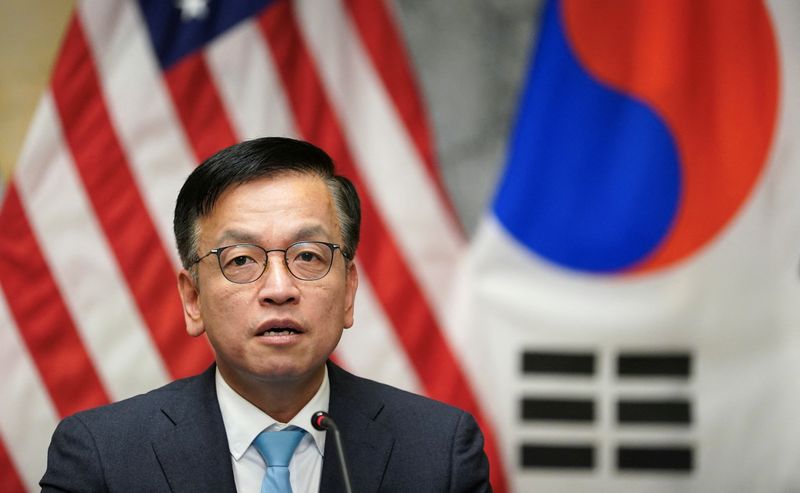
By Cynthia Kim
SEOUL (Reuters) -South Korea's finance ministry said on Wednesday it is ready to deploy "unlimited" liquidity into financial markets if needed after President Yoon Suk Yeol lifted a martial law declaration he imposed overnight that pushed the won to multi-year lows.
The announcement came after Finance Minister Choi Sang-mok and Bank of Korea Governor Rhee Chang-yong held emergency meetings overnight, and ahead of the BOK's extraordinary meeting session abruptly scheduled for 9 a.m. local time (0000 GMT) on Wednesday.
"All financial, FX markets as well as stock markets will operate normally," the government said in a statement.
"We will inject unlimited liquidity into stocks, bonds, short-term money market as well as forex market for the time being until they are fully normalised."
South Korea's won trimmed some losses early on Wednesday but stayed near two-year lows after Yoon lifted his shock martial law declaration, honoring a parliamentary vote against the measure.
South Korea's parliament, with 190 of its 300 members present, unanimously passed a motion on Wednesday requiring the martial law be lifted.
U.S.-listed South Korean stocks fell, while exchange-traded products in New York including iShares MSCI South Korea ETF and Franklin FTSE South Korea ETF lost about 1% each.
The Korean won also fell sharply against the yen to the weakest since May 2023, down 2.5%.
The political turmoil comes as Yoon and the opposition-controlled parliament clash over the budget and other measures.
The opposition Democratic Party last week cut 4.1 trillion won from the total budget proposal of 677.4 trillion won ($470.7 billion) the Yoon's government submitted, putting the parliament in a deadlock over control of the 2025 annual budget.
The parliamentary speaker on Monday stopped the revised budget from going to a final vote.
A successful budget intervention by the opposition would deal a major blow to Yoon's minority government and risk shrinking fiscal spending at a time when export growth is cooling.
"The negative impact to the economy and financial market could be short-lived as uncertainties on political and economic environment could be quickly mitigated on the back of proactive policy response," Citi economist Kim Jin-wook said in a report.
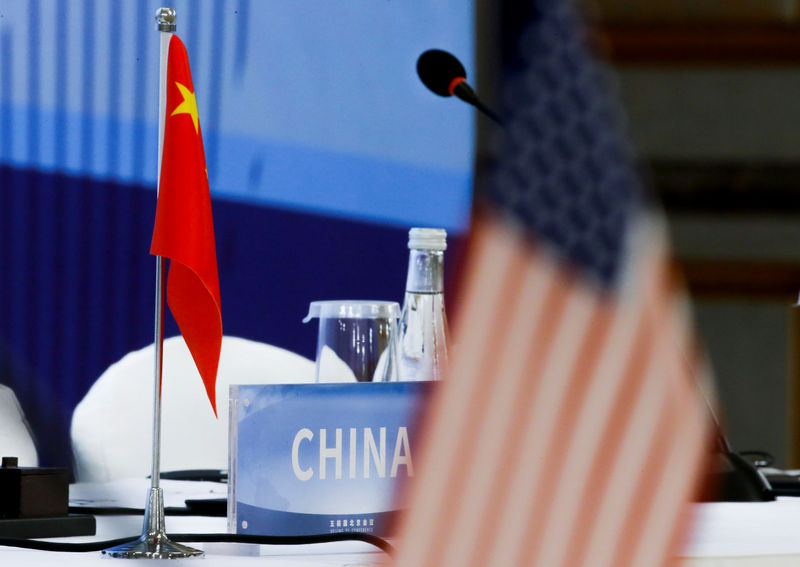
Investing.com-- A renewed U.S.-China trade conflict may be on the horizon as President-elect Donald Trump threatens new tariffs on Chinese imports, Bank of America (BofA) analysts said in a note.
Trump announced plans for a 10% tariff on Chinese goods and a 25% levy on imports from Mexico and Canada, citing concerns over fentanyl trafficking and immigration. BofA analysts expect these measures to intensify trade tensions and disrupt bilateral trade flows if implemented in early 2025.
"In theory, if Trump opts to adopt the executive order route to impose unilateral tariffs, the shock could come in shortly after he assumes office in early Jan. Else, if he instead chooses to ask Congress to enact new legislation, the tariff would kick in later but be harder to revoke," BofA analysts wrote.
The proposed tariffs echo the trade war of 2018-2020, which saw tariffs imposed on over half of U.S.-China trade, causing bilateral trade volumes to plummet. Chinese exports to the U.S. declined as tariffs increased, although Beijing managed to redirect some goods to alternative markets.
BofA analysts predict a similar trajectory if new tariffs are enacted. In a worst-case scenario, where a 60% blanket tariff is applied to Chinese imports, U.S. businesses dependent on Chinese goods could face severe disruptions. Key sectors, such as festive products and portable lamps, which source up to 90% of their imports from China, may struggle to find alternatives.
China is likely to respond cautiously, according to BofA. Although tit-for-tat tariffs are possible, China's smaller import volume from the U.S. limits the impact of such measures. Other options, like currency devaluation or restricting U.S. businesses in China, carry significant economic risks for Beijing, including potential capital outflows and diminished investor confidence.
Instead, Chinese policymakers may focus on stimulating domestic demand and exploring energy trade deals to mitigate losses. An increase in imports of U.S. goods, particularly liquefied natural gas (LNG) and oil, could be a negotiating tool to de-escalate tensions, BofA suggests.
While Trump’s stance reflects bipartisan support for reducing reliance on Chinese imports, BofA analysts see potential for negotiations. High U.S. inflation may reduce public tolerance for sweeping tariffs, which could exacerbate living costs and strain supply chains.
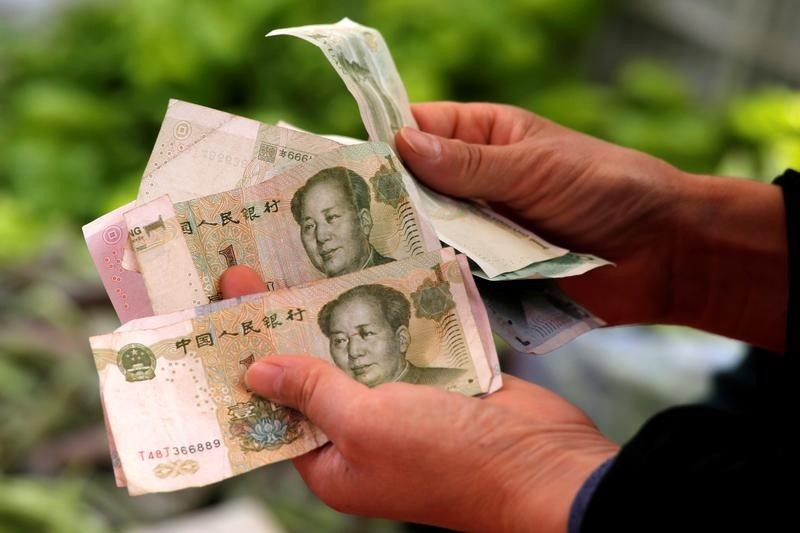
Investing.com-- Most Asian currencies extended declines on Tuesday with the Chinese yuan hitting a one-year low, as markets assessed the impact of new U.S. export restrictions targeting China’s semiconductor industry.
The U.S. is set to implement its third major crackdown on China's semiconductor industry, targeting 140 entities with new export restrictions aimed at curbing China’s access to advanced chips and equipment vital for artificial intelligence and other high-tech applications.
The move, which is seen as a direct challenge to China's technological ambitions, stirred volatility in regional currency markets, particularly for the Chinese yuan.
This comes at a time when sentiment around regional currencies had already been dampened due to U.S. President-elect Donald Trump's recent threat to impose 100% tariffs on goods from BRICS nations (Brazil, Russia, India, China, and South Africa) if they move to undermine the U.S. dollar by creating or backing alternative currencies. Before that, he vowed to impose additional tariffs on China.
Chinese yuan hits 1-yr low on new US export curbs
The Chinese yuan fell against the dollar, with the onshore USD/CNY pair rising 0.3% to its highest level since mid-November 2023.
The latest export restrictions are expected to exacerbate China’s challenges in its push for technological self-sufficiency, further dampening investor sentiment towards the yuan.
Markets across the region are closely watching the U.S.-China trade situation, with fears of further restrictions or retaliatory measures adding to the volatility.
The Australian dollar, which is sensitive to the Chinese economy, weakened slightly, with the AUD/USD pair remaining close to four-month lows. Third-quarter Australian gross domestic product data is due on Wednesday.
Dollar strength creates further pressure on Asia FX
Asian currencies have also faced downward pressure from the dollar, which gained for eight consecutive weeks before falling in the last one. Expectations of a slower rate cut path due to stubborn inflation and chances of inflation remaining high with the incoming president Trump have supported the greenback.
The US Dollar Index extended gains, inching up 0.1%, while the US Dollar Index Futures also ticked up 0.1%.
The South Korean won's USD/KRW pair, heavily influenced by semiconductor exports, was largely unchanged. South Korean consumer inflation read softer than expected for November, keeping the prospect of more interest rate cuts by the Bank of Korea in play.
The Japanese yen's USD/JPY pair rose 0.4%, and the Taiwan dollar's USD/TWD pair edged 0.2% higher, while India's USD/INR was muted.
The Philippine peso's USD/PHP pair was largely unchanged at 58.685 per U.S. dollar.
The Philippines revised its 2024 economic growth forecast, lowering the target to 6.0%–6.5%, down from a previous high of 7%. This adjustment comes amid ongoing domestic and global uncertainties, according to a government panel. Additionally, the peso’s expected average for 2024 has been adjusted to a range of 57.00–57.50 per dollar, from the earlier estimate of 56.00–58.00.
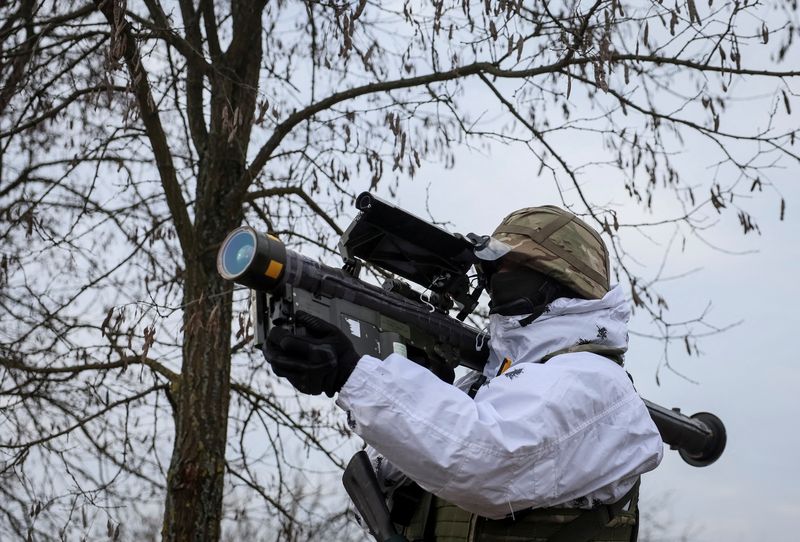
By Patricia Zengerle
(Reuters) -The United States will send Ukraine $725 million of missiles, ammunition, anti-personnel mines and other weapons, Secretary of State Antony Blinken said on Monday, as President Joe Biden's outgoing administration seeks to bolster Kyiv in its war with Russian invaders before leaving office in January.
The assistance will include Stinger missiles, ammunition for High Mobility Artillery Rocket Systems (HIMARS), drones and land mines, among other items, Blinken said in a statement.
Reuters reported last week that the Biden administration planned to provide the equipment, much of it anti-tank weapons, to ward off Russia's attacking forces.
Moscow's troops have been capturing village after village in Ukraine's east, part of a drive to seize the industrial Donbas region, while Russian airstrikes target a hobbled Ukrainian energy grid as winter sets in.
"The United States and more than 50 nations stand united to ensure Ukraine has the capabilities it needs to defend itself against Russian aggression," Blinken's statement said.
The announcement marks a steep uptick in size from Biden's recent use of so-called Presidential Drawdown Authority (PDA), which allows the U.S. to draw from current weapons stocks to help allies in an emergency.
Recent PDA announcements have typically ranged from $125 million to $250 million. Biden has an estimated $4 billion to $5 billion in PDA already authorized by Congress that he is expected to use for Ukraine before Republican President-elect Donald Trump takes office on Jan. 20.
WAITING FOR TRUMP
Trump is widely expected to change U.S. strategy on Ukraine, after he criticized the scale of Biden's support for Kyiv and made quickly winding down the war a central campaign promise. Last week, he picked Keith Kellogg (NYSE:K), a retired lieutenant general who presented him with a plan to end the war, to serve as special envoy for the conflict.
Kellogg's plan for ending the war, which began when Russia invaded Ukrainian sovereign territory, involves freezing the battle lines at their prevailing locations and forcing both Kyiv and Moscow to the negotiating table, Reuters reported in June.
The tranche of weapons represents the first time in decades that the United States has exported land mines, the use of which is controversial because of the potential harm to civilians.
Although more than 160 countries have signed a treaty banning their use, Kyiv has been asking for them since Russia launched its full-scale invasion in early 2022, and Russian forces have used them on the front lines.
The land mines that would be sent to Ukraine are "non-persistent," with a power system that lasts for just a short time, leaving the devices non-lethal. This means that - unlike older landmines - they would not threaten civilians indefinitely.
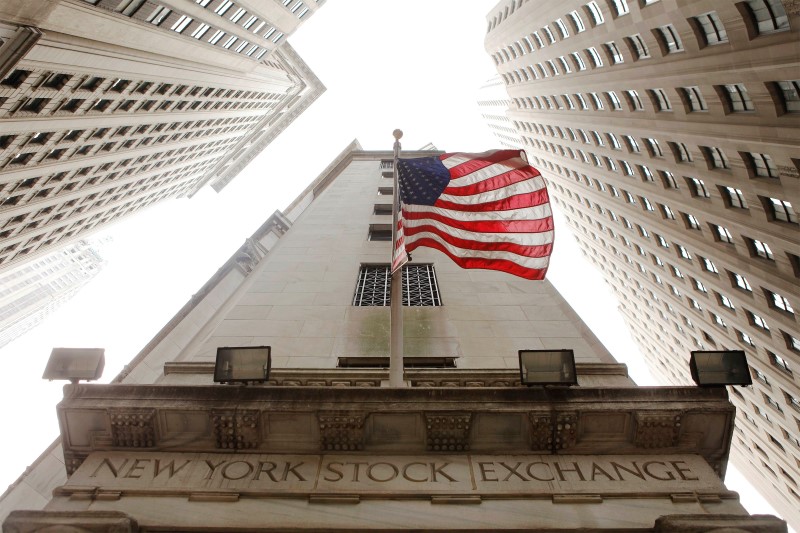
Investing.com-- U.S. stock index futures moved little on Monday evening after technology stocks spurred a positive session on Wall Street, with focus turning to more key signals on interest rates due this week.
Gains in tech helped markets weather threats of more tariff action from President-elect Donald Trump, who threatened to impose steep tariffs on the BRICS group of nations.
Comments from Federal Reserve officials also continued to trickle in, as investors maintained their bets on a 25 basis point cut in December. But data due this week is expected to factor into the upcoming rate decision.
S&P 500 Futures steadied at 6,063.0 points, while Nasdaq 100 Futures fell 0.1% to 21,206.75 points by 18:42 ET (23:42 GMT). Dow Jones Futures fell 0.1% to 44,881.0 points.
Fedspeak, payrolls data awaited
Focus this week is on addresses from a slew of Fed officials, most notably Chair Jerome Powell, for more cues on the central bank’s plans for interest rates.
While markets have so far maintained expectations for a December rate cut, the longer term outlook is more uncertain, especially on the prospect of inflationary policies under a Trump administration.
Trump's protectionist stance on trade and immigration is expected to potentially underpin inflation, keeping rates relatively high in the long term.
Focus this week is also on key nonfarm payrolls data for November, due on Friday. Strength in the labor market is expected to deter the Fed from cutting rates too quickly.
Fed Governor Christopher Waller said on Monday that while he leaned towards a 25 bps cut in December, data due in the coming days was likely to factor into the central bank’s decision.
Tesla falls as Delaware court rules against $56 bln Musk pay package
Among major aftermarket movers, Tesla Inc (NASDAQ:TSLA) fell more than 1% after a Delaware court upheld its decision to invalidate Elon Musk’s $56 billion compensation package.
The decision came even as Tesla shareholders voted to reinstate the package, and was deemed excessive by the court, which had first struck down the package in January.
Still, Tesla shares remained close to their highest levels since early-2022, as investors bet that the firm will benefit from Musk’s growing influence in Washington.
Tech puts S&P 500, Nasdaq at record highs, Dow lags
Gains in technology stocks underpinned Wall Street indexes on Monday, although the Dow fell from recent peaks amid some weakness in economically sensitive sectors.
The S&P 500 rose 0.2% to 6,047.15 points- a record high- while the NASDAQ Composite surged nearly 1% to a record high of 19,403.58 points. The Dow Jones Industrial Average fell 0.3% to 44,782.0 points.
Heavyweight tech stocks were the biggest boost to Wall Street, with the “Magnificent Seven” rising between 1.3% and 3.5%.
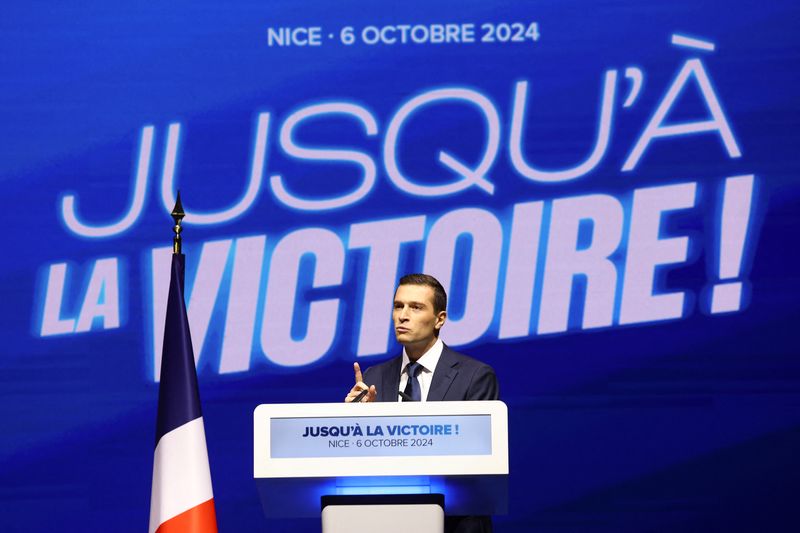
By Elizabeth Pineau and Ingrid Melander
PARIS (Reuters) - The French government is all but certain to collapse later this week after far-right and left-wing parties submitted no-confidence motions on Monday against Prime Minister Michel Barnier.
Investors immediately punished French assets as the latest developments plunged the euro zone's second-biggest economy deeper into political crisis, with serious doubt cast over whether the annual budget will be approved.
"The French have had enough," National Rally (RN) leader Marine Le Pen told reporters in parliament, saying Barnier, who only became prime minister in early September, had made things worse and needed to be pushed out. "We are proposing a motion of no confidence against the government," she said.
Barring a last-minute surprise, Barnier's fragile coalition will be the first French government to be forced out by a no-confidence vote since 1962.
A government collapse would leave a hole at the heart of Europe, with Germany also in election mode, weeks ahead of U.S. President-elect Donald Trump re-entering the White House.
RN lawmakers and the left combined have enough votes to topple Barnier and Le Pen confirmed her party would vote for the left-wing coalition's no-confidence bill on top of the RN's own bill. That vote is likely to be held on Wednesday.
The parties announced their no-confidence motions after Barnier said earlier on Monday that he would try to ram a social security bill through parliament without a vote as a last-minute concession proved insufficient to win RN's support for the legislation.
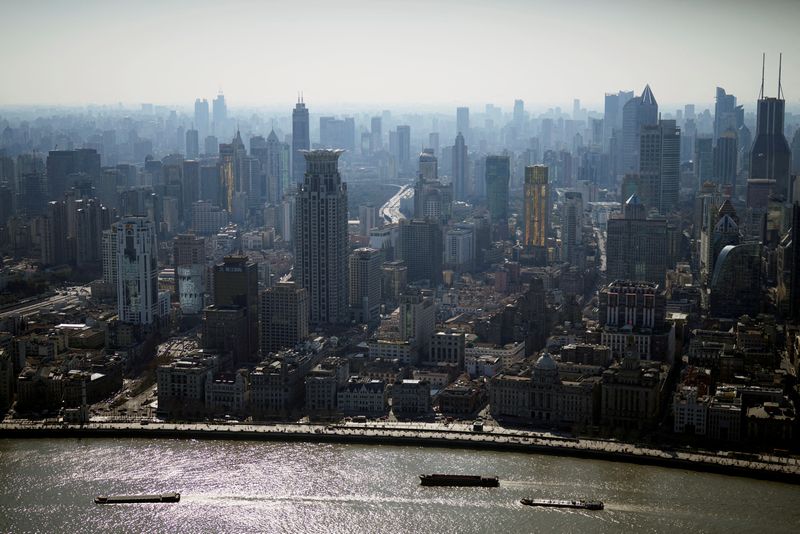
SHANGHAI (Reuters) -China's 10-year yield dropped below 2% to hit its lowest point on record on Monday, breaking a psychological barrier as a sputtering economy and bets on further rate cuts drive investors into the safety of bonds.
Prices in China's bond market have been on a decade-long rally - one that kicked into a higher gear roughly two years ago as the country's property sector woes and weakness in the stock market combined to prompt a flood of funds flowing into bank deposits and the debt market.
A ban on offering preferential deposit rates on Friday was the latest signal that rates are staying low.
Benchmark 10-year yields dropped 5 basis points (bps) to 1.9750% in Monday afternoon trade. That's the lowest point in data from China Central Depository & Clearing
Despite efforts from authorities to restrain the bond rally, including episodes of central bank selling and an increase in issuance, investor appetite seems insatiable and analysts expect the rally to continue into next year.
"Fundamentals are still very weak. Policies are merely support to prevent the economy from a hard landing, not a strong stimulus," said Ke Zong, a former portfolio manager at hedge fund Mingshi.
He added that previously hesitant funds and institutions were still under-allocated, and insurance companies often allocate in advance before the new year starts, driving down yields.
In addition to a cautious outlook for China's economic growth, the likelihood of U.S. tariffs on China imports mean China rates should rally next year, Morgan Stanley (NYSE:MS) strategists said in a note, adding that the bank's economists expect China's central bank to cut the policy rate by 40 bps by the end of the first quarter.
China's 10-year treasury futures, which move inversely to yields, jumped 0.4% on Monday to finish at a record closing high. The 30-year treasury yield fell 4 bps to 2.16%.
After spending much of the past ten years more than a hundred basis points higher than U.S. rates as China's economy hummed along, 10-year Chinese yields speared below U.S. rates in 2022 when China's economy fared much worse than the U.S. economy in the wake of the pandemic.
Chinese 10-year bonds now yield 222 bps less than their U.S. counterparts. The last time the gap was so large was in the early 2000s when global markets were recovering from the bursting of the internet stocks bubble.
DEPOSIT RATES DROP
The People's Bank of China (PBOC) has sought to bring deposit rates offered by banks to non-bank financial institutions such as brokerages and fund companies in line with the 7-day reverse repo rate, a policy rate, which is currently at 1.5%.
The policy pushes down short-term rates, and could "become a new driver for the downward trend in long-term bond yields," Yang Yewei, an analyst at Guoshen Securities, said in a note.
Indeed, the interest rate on one-year AAA-rated negotiable certificates of deposit (NCDs) dropped roughly 10 basis points on Monday to below 1.7%. NCDs are a popular short-term debt instrument issued between banks for their financing needs.
Funding conditions remain supportive for the bond bulls, even though more than 1 trillion yuan of refinancing bonds have been issued in November.
The PBOC said last Friday it injected 800 billion yuan via 3-month outright reverse repos and bought a net 200 billion yuan of government bonds in November.
Chen Jianheng, an analyst at China International Capital Corp, said in a recent webinar that loose monetary policy would reduce interbank deposit rates and help push down 10-year yields to around 1.7-1.9% next year.
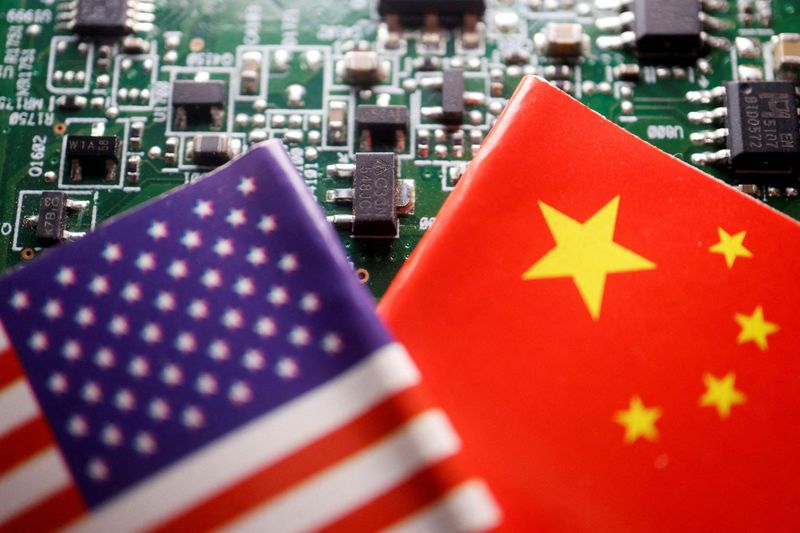
By Karen Freifeld and David Shepardson
(Reuters) - The U.S. will launch its third crackdown in three years on China's semiconductor industry on Monday, restricting exports to 140 companies including chip equipment maker Naura Technology Group, among other moves, according to two people familiar with the matter.
The effort to hobble Beijing's chipmaking ambitions will also hit Chinese chip toolmakers Piotech and SiCarrier Technology with new export restrictions as part of the package, which also takes aim at shipments of advanced memory chips and more chipmaking tools to China.
The move marks one of the Biden Administration's last large scale effort to stymy China's ability to access and produce chips that can help advance artificial intelligence for military applications or otherwise threaten U.S. national security.
It comes just weeks before the swearing in of Republican former president Donald Trump, who is expected to keep in place many of Biden's tough-on-China measures.
The package includes curbs on China-bound shipments of high bandwidth memory (HBM) chips, which are critical for high-end applications like AI training; new curbs on 24 additional chipmaking tools and three software tools; and new export restrictions on chipmaking equipment manufactured in countries including Singapore and Malaysia.
The tool controls will likely hurt Lam Research (NASDAQ:LRCX), KLA and Applied Materials (NASDAQ:AMAT), as well as non-U.S. companies like Dutch equipment maker ASM International (AS:ASMI).
Among Chinese companies facing new restrictions are nearly two dozen semiconductor companies, two investment companies and over 100 chipmaking tool makers, the sources said. U.S. lawmakers say some of the companies, including Swaysure Technology Co, Qingdao SiEn, and Shenzhen Pensun Technology Co, work with China's Huawei Technologies, the telecommunications equipment leader once hobbled by U.S. sanctions and now at the center of China's advanced chip production and development.
They will be added to the entity list, which bars U.S. suppliers from shipping to them without first receiving a special license. China has stepped up its drive to become self-sufficient in the semiconductor sector in recent years, as the U.S. and other countries have restricted exports of the advanced chips and the tools to make them. However, it remains years behind chip industry leaders like Nvidia (NASDAQ:NVDA) in AI chips and chip equipment maker ASML (AS:ASML) in the Netherlands.
The U.S. also is poised to place additional restrictions on Semiconductor Manufacturing International, China's largest contract chip manufacturer, which was placed on the Entity List in 2020 but with a policy that allowed billions of dollars worth of licenses to ship goods to it to be granted.
For the first time, the U.S. will add two companies that make investments in chips to the entity list. Chinese private equity firm Wise (LON:WISEa) Road Capital and tech firm Wingtech Technology Co will be added.
Companies seeking licenses to ship to firms on the Entity List generally get denied.
DUTCH AND JAPANESE EXEMPTED
An aspect of the new package that addresses the foreign direct product rule could hurt some U.S. allies by limiting what their companies can ship to China. The new rule will expand U.S. powers to curb exports of chipmaking equipment by U.S., Japanese, and Dutch manufacturers made in other parts of the world to certain chip plants in China.
Equipment made in Malaysia, Singapore, Israel, Taiwan and South Korea is subject to the rule while the Netherlands and Japan will be exempt. The expanded foreign direct product rule will apply to 16 companies on the entity list that are seen as the most important to China's most advanced chipmaking ambitions.
The rule will also lower to zero the amount of U.S. content that determines when certain foreign items are subject to U.S. control. That will allow the U.S. to regulate any item shipped to China from overseas if it contains any U.S. chips.
The new rules are being released after lengthy discussions with Japan and the Netherlands, which, along with the U.S., dominate the production of advanced chipmaking equipment. The U.S. plans to exempt countries that put in place similar controls, the people said.
Another rule in the package restricts memory used in AI chips that correspond with what is known as "HBM 2" and higher, technology made by South Korea's Samsung and SK Hynix and U.S.-based Micron (NASDAQ:MU). Industry sources only expect Samsung Electronics (KS:005930) to be impacted. The latest rules are the third major package of chip-related export restrictions on China implemented under the Biden administration. In October 2022, the U.S. published a sweeping set of controls to curb the sale and manufacture of certain high-end chips which were considered to be the biggest shift in U.S. tech policy toward China since the 1990s.
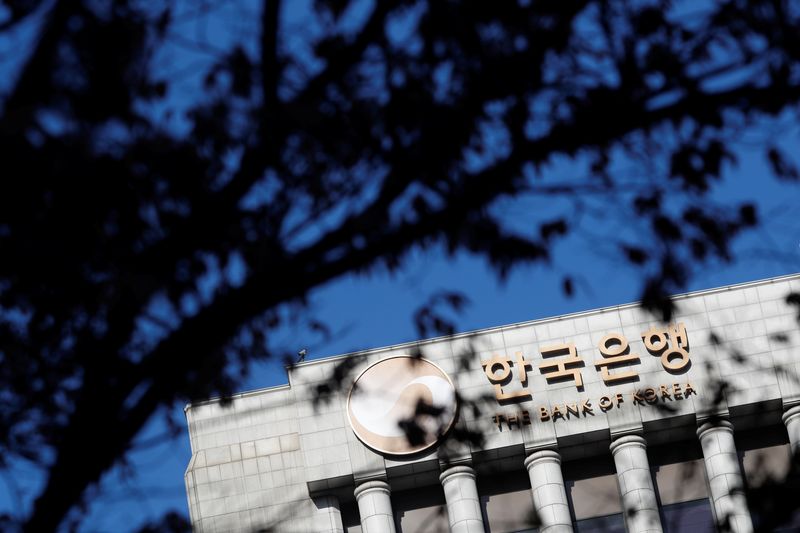
By Anant Chandak
BENGALURU (Reuters) - The Bank of Korea will take a pass in January but cut interest rates by a quarter-point in February following an unexpected reduction on Thursday to support a weakening economy, according to economists in a Reuters snap poll.
To boost activity in Asia's fourth-largest economy, which narrowly avoided a recession last quarter, the BOK cut rates for a second meeting in a row on Nov. 28 - the first back-to-back reductions since early 2009. Inflation has largely stayed under control.
However, BOK Governor Rhee Chang-yong said the future remains uncertain given President-elect Donald Trump's plans to hike tariffs. The U.S. is one of South Korea's largest export destinations.
A strong majority of economists, 16 of 22 in a snap poll conducted Nov. 28-29, forecast the BOK would cut its base rate by 25 basis points to 2.75% in February.
The other six predicted the next quarter-point cut would come in January.
"We now expect one more cut as early as February 2025 and a faster recalibration of policy stance to neutral ... while acknowledging uncertainties related to U.S. trade policy – the timing of the tariffs, their coverage, and their magnitude – could alter the path," Bum Ki Son, economist at Barclays (LON:BARC), said.
He was one of the few economists to correctly predict the surprise November cut.
"With the BOK's concern on growth also becoming structural, given intensified competition and China's aggressive investment, we believe the speed of policy normalisation to neutral could be faster than we expected," Bum Ki Son added.
Median forecasts indicated a cumulative 75 basis-point cut next year, bringing the policy rate to 2.25% by end-September, compared with 2.50% expected in a poll taken before Thursday's central bank meeting.
But there was no clear consensus on the rate at end-September, with 11 of 22 economists forecasting 2.25%, 10 saying 2.50% and one 2.00%.
"The tone of the statement and Governor Rhee's press conference makes clear that further easing is on the way and that supporting economic growth was now the central bank's main priority," Gareth Leather, senior Asia economist at Capital Economics, said.
"We expect growth to struggle over the coming year. Although exports should continue to perform strongly, this is likely to be offset by further weakness in the labour market and the continued struggles of the property sector."
The BOK downgraded its forecast for economic growth in 2025 to 1.9%, weaker than the previous forecast of 2.1%.
(Other stories from the November Reuters global economic poll)
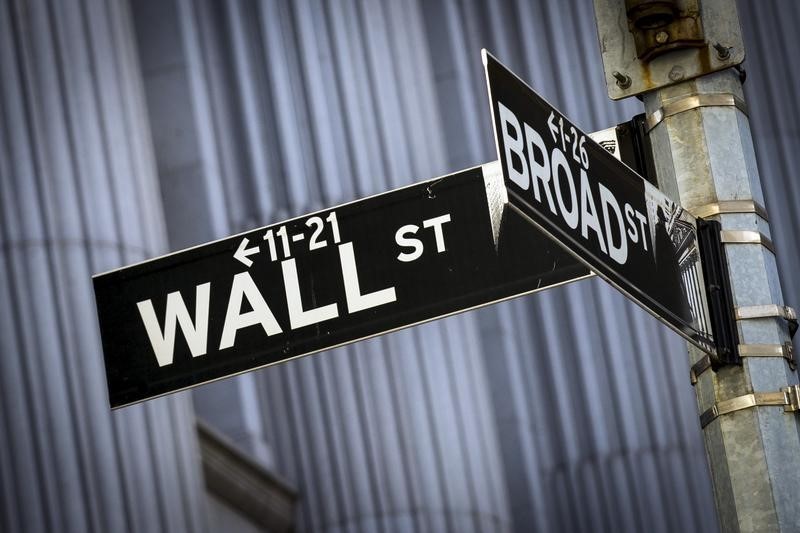
Investing.com-- U.S. stock index futures fell slightly on Sunday evening following more warnings of trade tariffs from President-elect Donald Trump, while investors also awaited a slew of cues on interest rates this week.
Futures fell after Wall Street indexes raced to record highs on Friday, as investors cheered persistent signs of resilience in the U.S. economy. Investors also largely maintained bets that the Federal Reserve will cut interest rates in December.
S&P 500 Futures fell 0.1% to 6,047.50 points, while Nasdaq 100 Futures fell 0.1% to 20,971.75 points by 19:03 ET (00:03 GMT). Dow Jones Futures fell 0.1% to 45,028.0 points.
Trump threatens ‘100% tariffs’ against BRICS countries
Trump on Sunday threatened to impose “100% tariffs” on the BRICS bloc of countries, which includes China.
Trump criticized the bloc’s attempts to form its own currency and shift away from the U.S. dollar, threatening to cut the bloc off from U.S. trade over the move. He called for commitments to the dollar from the bloc.
Trump’s latest comments come after he had last week threatened higher import tariffs against China, Mexico and Canada, rattling global markets with the prospect of more protectionist policies in the U.S.
Investors also feared retaliatory measures from U.S. trading partners, especially China, which could spark a renewed trade war between the world’s biggest economies.
Wall St at record highs with rate cues in focus
Wall Street indexes surged to record highs in shortened trading on Friday, as investors cheered recent signs of resilience in the economy and also maintained bets that the Fed will cut rates later in December.
Investing.com-- U.S. stock index futures fell slightly on Sunday evening following more warnings of trade tariffs from President-elect Donald Trump, while investors also awaited a slew of cues on interest rates this week.
Futures fell after Wall Street indexes raced to record highs on Friday, as investors cheered persistent signs of resilience in the U.S. economy. Investors also largely maintained bets that the Federal Reserve will cut interest rates in December.
S&P 500 Futures fell 0.1% to 6,047.50 points, while Nasdaq 100 Futures fell 0.1% to 20,971.75 points by 19:03 ET (00:03 GMT). Dow Jones Futures fell 0.1% to 45,028.0 points.
Trump threatens ‘100% tariffs’ against BRICS countries
Trump on Sunday threatened to impose “100% tariffs” on the BRICS bloc of countries, which includes China.
Trump criticized the bloc’s attempts to form its own currency and shift away from the U.S. dollar, threatening to cut the bloc off from U.S. trade over the move. He called for commitments to the dollar from the bloc.
Trump’s latest comments come after he had last week threatened higher import tariffs against China, Mexico and Canada, rattling global markets with the prospect of more protectionist policies in the U.S.
Investors also feared retaliatory measures from U.S. trading partners, especially China, which could spark a renewed trade war between the world’s biggest economies.
Wall St at record highs with rate cues in focus
Wall Street indexes surged to record highs in shortened trading on Friday, as investors cheered recent signs of resilience in the economy and also maintained bets that the Fed will cut rates later in December.

